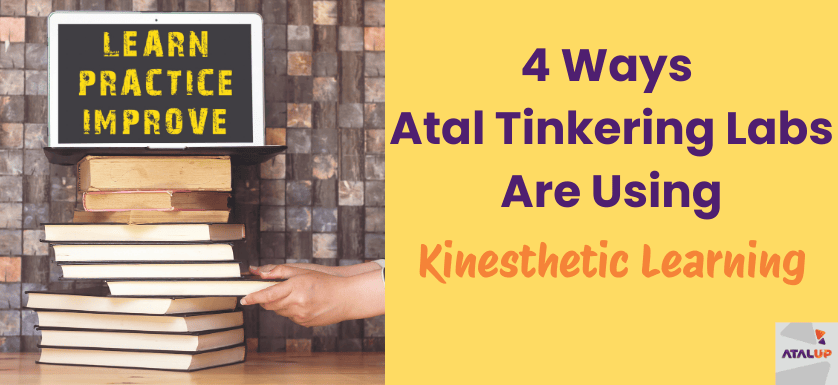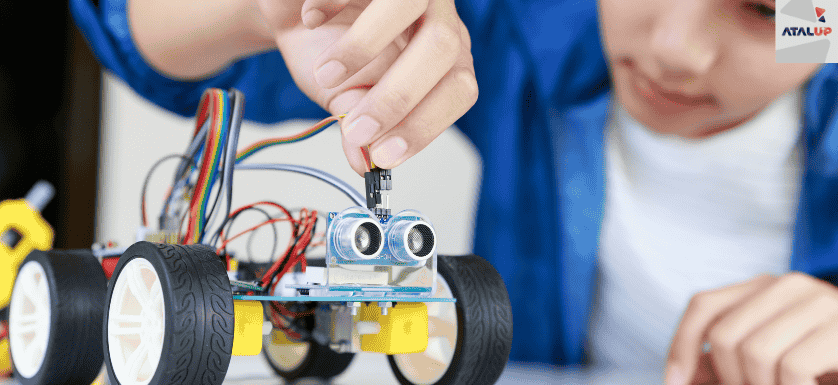
For decades, Indian classrooms have followed a “chalk-and-talk” model, textbooks, lectures, exams, and endless note-taking. While this traditional setup may check academic boxes, it rarely inspires innovation or real-world problem-solving. Students know theories but can’t apply them. Concepts are memorized but forgotten. This outdated pattern needs a shake-up.
That’s where kinesthetic learning comes in. It’s not just a new buzzword, it’s a shift toward learning that actually sticks. According to a study, 18% of the survey participants were categorized as Kinesthetic learners. Imagine a big chunk of learners we are missing out on! Let’s dive deeper into this.
What Is Kinesthetic Learning?
Kinesthetic learning is a learning style where students understand concepts by physically doing activities, rather than passively reading or listening. This style encourages hands-on exploration, touching, building, experimenting, and interacting with real objects.
Unlike auditory or visual learning styles, kinesthetic learners retain information through movement and experience. For instance, they won’t just read about Newton’s laws, they’ll test them with ramps, balls, and motion sensors.
Learners remember up to 75% of what they do, but only 10% of what they hear or read. That’s what research from the National Training Laboratories shows. Active participation doesn’t just help; it supercharges retention.
Despite these numbers, most schools don’t support it. Why not give students a chance to learn in the way that suits them best? Atal Innovation Mission and NITI Aayog have introduced Atal Tinkering Labs to promote the Kinesthetic learning style in India. It focuses on learning by doing.
Kinesthetic Learning Examples That Actually Work
Let’s make it real. Here are some kinesthetic learning examples that help you visualize the impact:
- Instead of reading about circuits, students build an LED lighting system using breadboards and batteries.
- Rather than memorizing concepts of gravity, they design and drop parachutes from different heights to study air resistance.
- Students explore renewable energy by constructing solar-powered fans or mini wind turbines.
These aren’t just cool activities, they’re structured projects that build STEM skills, critical thinking, and creativity on the grounds of Kinesthetic learning.
How Atal Tinkering Labs Promote Kinesthetic Learning
ATLs are equipped with tools for robotics, electronics, 3D printing, IoT, and more. With access to real materials and real problems, students don’t just learn, they experience.
Every ATL project follows the kinesthetic learning style by encouraging students to build, test, and improve their ideas. Whether it’s coding a sensor-based parking system or crafting a model for flood management, these activities push students to apply classroom knowledge to solve real issues, many of them rooted in their local communities.
For rural and semi-urban students, ATLs also connect STEM education with agricultural needs. In many rural places students have created soil moisture sensors and automatic irrigation systems, combining innovation with impact.
Students from St. Paul’s CEHSS, Thrissur built a smart farm model that detects wild animals and controls irrigation. With sensors and automation, it protects crops from both wildlife and water waste.
According to a blog, Students at St Mary’s Convent Girls Higher Secondary School built smart goggles to assist the visually challenged. These goggles use an ultrasonic sensor to detect obstacles and instantly trigger a buzzer, alerting the wearer about potential danger. This simple yet powerful innovation boosts spatial awareness and helps users move around safely and independently.
Why School Teachers, Principals, and Parents Should Focus on ATLs?
1. Hands-On Learning Boosts Retention
When students actively engage with tools, sensors, and machines, they don’t just memorize concepts, they understand them. In ATL Labs, building a model or testing a circuit helps students remember lessons far more effectively than reading from a textbook. They learn by doing, and that experience stays with them longer.
2. Real-World Problem-Solving Becomes Second Nature
ATLs encourage students to look around, identify challenges in their surroundings, and create tech-based solutions using the Kinesthetic learning style. Whether it’s designing a flood alert system for their village or building a smart irrigation setup, students directly apply science and math to solve real-life problems. That kind of learning makes education meaningful.

3. Students Build Confidence And Unlock Creativity
Tinkering, making mistakes, and trying again in ATL Labs gives students the confidence to innovate. They’re not afraid to experiment. As they explore sensors, robotics, and 3D printing, they begin to see themselves as creators, not just learners. This environment nurtures curiosity and sparks original thinking.
4. Diverse Learners Get A Fair Chance To Shine
Not every student excels through reading or listening. Some grasp ideas better when they use their hands i.e. Kinesthetic learning. ATLs give these kinesthetic learners the space to explore, participate, and thrive. It’s inclusive learning at its best, where every child finds a way to connect with STEM.
ATALUP: Helping Schools Embrace Kinesthetic Learning
While ATL Labs are a brilliant initiative, the process of getting one can be confusing. That’s where ATALUP comes in, a support system for schools that want to set up and run ATL Labs smoothly.
Here’s how ATALUP helps:
Eligibility Check: Not sure if your school qualifies for the ₹20 lakh ATL grant? ATALUP helps you find out instantly.
Is your school eligible for
Atal Tinkering Lab
Application Assistance: From filling out the Letter of Intent to submitting the detailed form and signing the MoU, ATALUP guides you at every step.
Lab Setup & Training: Once approved, ATALUP helps design the lab, align it with STEM goals, and train teachers to manage kinesthetic learning activities.
Ongoing Support: Need help with ATL calendar planning or student engagement strategies? ATALUP stays with you beyond setup.
In short, ATALUP ensures your school doesn’t just get an ATL, it uses it to its full potential.
Final Thoughts
In today’s fast-changing world, students need more than theory, they need the confidence to build, test, and innovate. Kinesthetic learning is no longer optional, it’s essential. With Atal Tinkering Labs and the right support from ATALUP, schools across India can finally give students the learning experience they deserve.
Let’s move from memorization to creation. From passive to hands-on. From classroom-bound to future-ready.